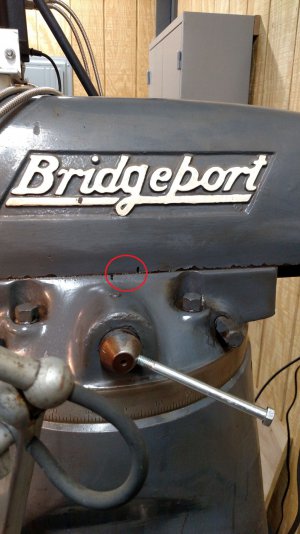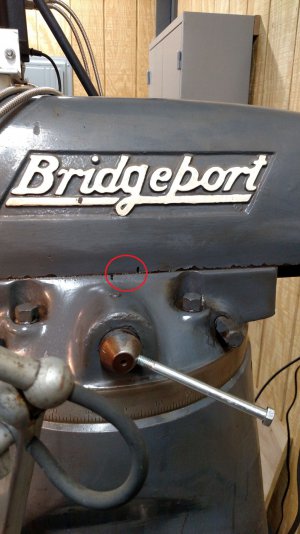When I bought my 1967 V-ram 9x42 Series 1 Bridgeport mill a few years ago, the ram pinion handle was broken off flush. I assumed the ram was stuck, hence the broken handle, but hadn't investigated any further.
Thankfully, there was no evidence that anyone had attempted to force the ram by using a pipe wrench on the pinion as I have read about.
I've been using the mill with the ram where it sat without problem, but I got the bug recently to free it up.
The web had a wealth of accounts of others' experiences while freeing up their ram. I expected my experience would be similar, so I picked up some WD40 rust dissolving penetrating oil in an aerosol can with the straw, and an easy-out to remove and replace the broken pinion handle.
I sprayed the penetrating oil in all the nooks and crannies, and scotch-brighted the accessible dovetail surfaces. The oil would soak in while I worked on the broken pinion handle.
I removed the pinion easily after unscrewing the keeper screw. It was quite clean with no evidence of rust nor overstress.
Simply unscrewing the broken 3/8in stub from the pinion by tapping it tangentially with a small hammer and center punch was only partially successful. It did move about a half-turn but then locked. I worked it back and forth a little, but it would only turn so far. Then I drilled a hole into the center of the stub, and screwed in the easy-out. I was able to gingerly unscrew the stub an additional half-turn or so, then snap! The easy-out broke! I don't think I've ever had a happy ending with an easy-out.
I debated simply milling some flats on the pinion, as others have done, so I could use an open-end wrench on it here-after, but decided to attempt to remove the broken easy-out and continue to work on the broken stub. If I buggered it up badly I could still mill two flats on the pinion.
I drilled small holes around the broken easy-out and was able to pick it out. I then enlarged the hole until I could remove the pieces of the broken stub. Unfortunately, I had damaged the threads a little bit. I was able to chase the threads with a fresh 3/8in bolt but I've decided I'll likely drill and tap to a larger size. The temporary bolt would hold well enough while I resumed the task of freeing up the ram.
I painted a line across the seam between the ram and the turret, with a Sharpie marker, so it would be obvious when and if the ram moved.
I applied a fresh dose of the penetrating oil, loosened the ram locking bolts, and put two of the squeeze-handle type Irwin clamps on either side of the ram. I was about to turn off the shop lights and call it an evening, but I checked my magic marker line one last time and found that it had split about 1/4inch!
Shocked the heck out of me! I know this ram hasn't moved in about 8 years. 3 years while it's been in my possession, and about 4-5 years while it sat in the pawn shop where I found it!
The clamps had indeed slackened a little bit. I removed the clamps and was able to move the ram back and forth about an inch and a half with the temporary pinion handle! It was stiff, and it would then tighten up but seemed to come to a "soft" stop, so I'm hopeful that after some additional application of the penetrating oil, and some time, it will free up for the entire travel.
I thought it would take me a large portion of my weekend to free up the ram, or longer, but it only ended up taking a couple of hours including the time spent removing the broken handle stub. Must be the Irish in me, and the fact that the ram just wasn't severly stuck after all!
I'll probably just move the ram back to where it's been sitting and lock it down. But I'll know it's not stuck anymore!


Thankfully, there was no evidence that anyone had attempted to force the ram by using a pipe wrench on the pinion as I have read about.
I've been using the mill with the ram where it sat without problem, but I got the bug recently to free it up.
The web had a wealth of accounts of others' experiences while freeing up their ram. I expected my experience would be similar, so I picked up some WD40 rust dissolving penetrating oil in an aerosol can with the straw, and an easy-out to remove and replace the broken pinion handle.
I sprayed the penetrating oil in all the nooks and crannies, and scotch-brighted the accessible dovetail surfaces. The oil would soak in while I worked on the broken pinion handle.
I removed the pinion easily after unscrewing the keeper screw. It was quite clean with no evidence of rust nor overstress.
Simply unscrewing the broken 3/8in stub from the pinion by tapping it tangentially with a small hammer and center punch was only partially successful. It did move about a half-turn but then locked. I worked it back and forth a little, but it would only turn so far. Then I drilled a hole into the center of the stub, and screwed in the easy-out. I was able to gingerly unscrew the stub an additional half-turn or so, then snap! The easy-out broke! I don't think I've ever had a happy ending with an easy-out.
I debated simply milling some flats on the pinion, as others have done, so I could use an open-end wrench on it here-after, but decided to attempt to remove the broken easy-out and continue to work on the broken stub. If I buggered it up badly I could still mill two flats on the pinion.
I drilled small holes around the broken easy-out and was able to pick it out. I then enlarged the hole until I could remove the pieces of the broken stub. Unfortunately, I had damaged the threads a little bit. I was able to chase the threads with a fresh 3/8in bolt but I've decided I'll likely drill and tap to a larger size. The temporary bolt would hold well enough while I resumed the task of freeing up the ram.
I painted a line across the seam between the ram and the turret, with a Sharpie marker, so it would be obvious when and if the ram moved.
I applied a fresh dose of the penetrating oil, loosened the ram locking bolts, and put two of the squeeze-handle type Irwin clamps on either side of the ram. I was about to turn off the shop lights and call it an evening, but I checked my magic marker line one last time and found that it had split about 1/4inch!
Shocked the heck out of me! I know this ram hasn't moved in about 8 years. 3 years while it's been in my possession, and about 4-5 years while it sat in the pawn shop where I found it!
The clamps had indeed slackened a little bit. I removed the clamps and was able to move the ram back and forth about an inch and a half with the temporary pinion handle! It was stiff, and it would then tighten up but seemed to come to a "soft" stop, so I'm hopeful that after some additional application of the penetrating oil, and some time, it will free up for the entire travel.
I thought it would take me a large portion of my weekend to free up the ram, or longer, but it only ended up taking a couple of hours including the time spent removing the broken handle stub. Must be the Irish in me, and the fact that the ram just wasn't severly stuck after all!
I'll probably just move the ram back to where it's been sitting and lock it down. But I'll know it's not stuck anymore!


Last edited:

